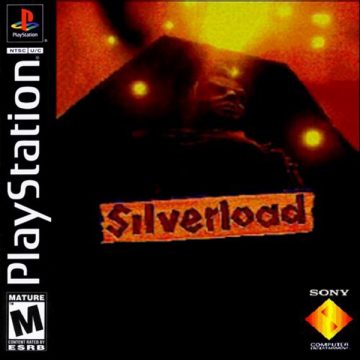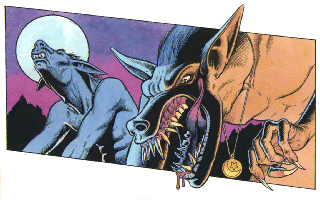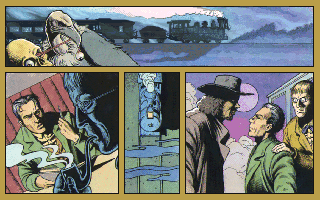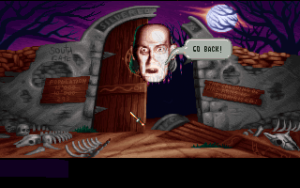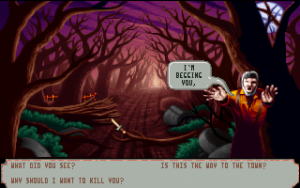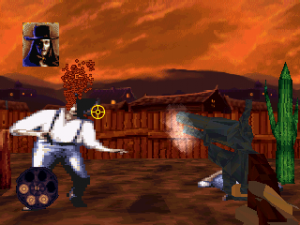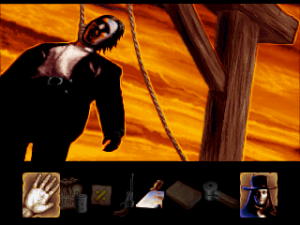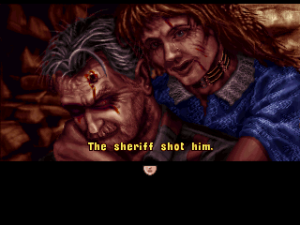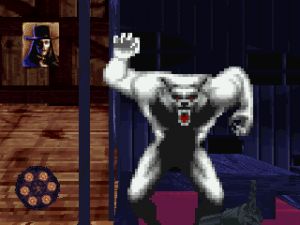“Devils in the bodies of men!” warns a weary frontiersman by the campfire, in Jason Wilson’s wild west horror set in 1879. So begins your quest as a mysterious stranger coming across a band of travelers recently attacked, the child of the frontiersman having been taken in the process. A storm tainted by evil has gathered and the other survivors don’t trust you, but this man by the fire implores that you bring back his son from the eponymous town of Silverload. Immediately the atmosphere is one of foreboding and dread, as you realise there’s ungodly abominations roaming the land and your standard six shooter might not be enough. Released on PC and later updated for PS1, there are substantial differences between the two.
The console release is surprisingly trickier than its computer originator, notably from the first puzzle: you need to enter the caravan of a survivor, listen to his wife’s admonishment, and accept the survivor’s compass. This will guide you through the storm. Next you need to open a chest, take a child’s toy bear, receive another admonishment, and then – here’s the tricky bit – click on the empty space beneath bear to find the hidden goggles. These will protect your eyes while wandering through the storm. From here the game shows an element of brilliant design which it never really exploits enough: you need to equip the compass to your hand and the goggles to your face, thereby allowing you to progress. In the PC version the goggles are the first item in the chest, and you don’t need to equip anything to navigate the storm, it just happens. After this excellent opening though even the PSOne update abandons the idea of equipable items and follows standard procedure for point-and-clicks, with you selecting inventory items and applying them to the environment directly.
Silverload, at least the PS1 update, has a number of clever ideas to separate it from the rest of the adventure game pack. Time only progresses after collecting a specific number of key items, thereby preventing you from missing something essential. You can still fail due to not buying enough bullets or healing items, but at least you’re unlikely to reach the end and find you’re missing something essential. Every time a key item is found a bell chimes, signalling that you’re on the right track. There are also some 3D action sequences which play like Virtua Cop, and unlike many other adventure games where the action sequences feel out of place and are annoying, they’re a lot of fun here. Rather easy too, which is nice. The best thing about Silverload though is its unique story, which weaves together Native American shamanism, satanic priests, human sacrifice, and werewolves.
Roughly 20 years ago a land deed was acquired to mine silver in the mountains, and from here the town of Silverload was born. Local men set about making it more habitable, hunting down and wiping out all the wolves which lived in the surrounding forests. But these wolves hunted with the local Native American population, and it was their land which was taken. After visiting the town to enquire where their wolf kin are, Silverload’s priest persuades the mayor and sheriff that they natives an ungodly people and, like the wolves, must be wiped out. So off they ride, to slaughter men, women and children, the sheriff procuring a native’s heart as requested by the priest. But they failed to kill the tribe’s shaman, who places a curse on the entire town, turning the populace into either vampires or werewolves, since they had previously hunted the wolves to extinction, while because of their greed for silver the substance is now deadly to the touch. Unable to leave Silverload due to this curse, the priest takes control and the people carry on, feeding off unsuspecting passers by.
Every line of dialogue is voiced and, in the PSOne version, the voice acting is excellent. Some reviews for Silverload have been critical of the voice acting, but it has to be asked: what did these reviewers expect? It’s a horror game set in the wild west, not a theatrical retelling of Chaucer. The mix of exaggerated villains with a southern accent suit the setting perfectly, as do those with European accents, since it was a time of emigration. With the exception of the gun store owner whose stuttering takes too long, all the voices perfectly suit the characters, from the sultry and provocative saloon whore to the satanic priest himself. Games from 1995 are not renowned for their good acting, and Silverload is a cut above the rest from that era.
Characters
Gunslinger
This is you, the mysterious hero, a half native-American Indian raised by a white couple. Although it seems coincidence that you stumbled across the recently attacked settlers, you actually have a connection to the town, buried in childhood memories.
Campfire Man
His wife passed away some time ago and now his son has been kidnapped. He begs you to save his son, saying he would trade his life for it. Gives you some food rations if you keep talking.
Survivor and Wife
The wife takes a disliking to you but the husband, wounded in the recent raid, gives you his compass to help navigate the storm. Be sure to go through their trunk and take the goggles.
Hotel Owner
He doesn’t take kindly to strangers and he especially doesn’t take kindly to gunslingers. If you’re careful during conversation he might be persuaded to let you stay the night. Otherwise it’s off to the barn.
Leo Remington
An anthropologist who came to Silverload with his colleague Carl Whitehead, to retrieve a collection of cursed Indian relics. Locked in his room and terrified, the only way to reach him is through a secret passage.
Cain
This young upstart is a resident of Silverload and leader of a small gang that likes to rough up outsiders. You can avoid his wrath by acting obsequious, but it’s much more fun to piss him off and put a bullet in his head and those of his gang.
Store Owner
A grumpy Scotsman who isn’t actually a bad guy. You’ll want the lamp, oil, matches and as much healing items as you can carry. Stop by regularly for the bandage and blue ointment.
Barber
A curious accent for an even more curious gentlemen. The question is, in a town of werewolves and vampires, would you let a man near your throat with a razor?
Carl Whitehead
Colleague of Leo Remington, you find him inside the blacksmith’s undergoing transformation into a vampire. He begs for blood, and until this lust is satiated he will attack if you get too close. Lucky thing there’s a pig slaughterhouse nearby.
Barman
He doesn’t own the saloon, he just runs the bar. You can buy whiskey, ale or tequila off him, but otherwise he’s not much good for local gossip. Pick up two ales while you’re here.
Undertaker
Stereotypically creepy undertaker, he’s willing to photograph you with two recently shot criminals. If you distract him somehow, so he’s not looking, you can steal two extremely valuable items from around his establishment.
Gambler
A drifter who stops by to make a little money with the dice and enjoy the company of questionable ladies. It’s worth speaking with him since it’s the only way to increase your money. If you find the loaded dice and equip them in your hand, they will throw the game in your favour. But after four attempts the gambler grows wise and refuses to play anymore, so be sure to bet $3 each time.
Town Idiot
He’s paid by the townsfolk to do odd jobs, like hauling equipment to the mine and back. As such he’s rather tired and asks you to get him something. Perhaps there’s a way to make him fall asleep? If he does doze off, the contents of his cart are ripe pickings. Make sure you grab everything.
Sheila
A sultry minx in black at the saloon. She’s portrayed as the local whore, but it’s quite clear that only the sheriff is allowed to touch her. It seems that in a town of demons and insanity she’s the only one you can trust – but is she telling you everything?
Sheriff
Second in command to the Satanic Priest running the show, this is one mean bad guy. You can visit him at the town jail at the game’s start, and he makes it quite clear you’re not welcome. Has committed some terrible atrocities over the years.
Unfortunately for all its good ideas, fantastic setting, great script and suitable voice acting, Silverload does suffer from some rather serious problems. The first is common to many old adventure games: some of the puzzles are extremely obtuse and, without a hint system, will require a guide to complete unless you like trial and error. Finding Carl Whitehead in the blacksmith’s, begging for blood, astute players might be able to deduce that they need to acquire blood from the nearby pig slaughterhouse to feed him. Having stumbled across the butcher’s knife earlier (it’s easy to find) they might even be able to work out they need to cut down the hanged man near the graveyard, taking the rope as a matter of course, and then using it on the well outside the blacksmith’s since it seems likely (wells have ropes attached normally). This would yield the bucket which, in conjunction with the butcher’s knife, allows collection of the pig’s blood. There’s a chance all this could be fathomed naturally, and so the raving man is fed. But once he leaves, and his iron tongs can be picked up, it’s a massive leap of logic to then take these tongs and use them on the statue in the town square to acquire a special medallion which grants access to the mines. Though even when using a guide, which explains everything, it’s still not easy since as in the above example the tongs need to be applied to the statue in a very specific place.
And here lies the biggest problem with Silverload, for both versions. Icons and objects are massive and oddly shaped, making it difficult to work out what needs clicking where. Even something as simple as paying the barman for a tankard of ale he’s holding proves problematic since the money bag is a round indistinct object, and the tankard is also large, whereas the hotspots for these two items meeting is small and very specific – ironically paying for said beverage requires fumbling around like the proverbial town drunk. The process of clicking on things is all akin to playing pool with a piece of rope, and it would have been much better if they’d just stuck with a standard pointer. Another example is movement: the move icon is represented by an L-shaped boot, with its trigger point appearing to be the middle of the shin, with the hotspots for moving between areas randomly placed around the edge of the screen. It’s workable after a little trial and error, but until you memorize the closely placed hotspots in the town square you may be confused as to why you’re suddenly in the wrong area.
In contrast, the 3D shooting sections are very slick and extremely awesome – although there’s only about three or four they are some of the best bits in Silverload. Playing with a controller on the PS1 version the icon slides across the screen with momentum when you press the d-pad, rather than moving slowly and with precision. This sounds like it should be awful, but because the collision boxes for enemies are generous it actually works extremely well. Movement is fast and the enemies drop quickly, and even if you sometimes miss you can still recover. Strategy comes from deciding when to reload, which is quite slow, and it’s rather thrilling as you have to decide whether 2 bullets in the barrel will be enough or not. Any damage taken can be healed afterwards using items bought at the general store. Although these shooting sections are very easy (which is better than being too difficult), they add some variety.
Interface problems for the point-and-click sections could very likely kill a game in this genre, but what saves Silverload and encourages you to persevere is the unparalleled atmosphere and setting. While there have been quite a few horror adventure games there aren’t quite as many westerns, and certainly no others which combine the two genres. The overall tale is also fairly well written, rather chilling and portrayed via some very graphic imagery. There have been some extremely critical reviews for Silverload online, but mostly these are a little harsh. It has its flaws, but overall the good parts outweigh the negatives enough to warrant at least one playthrough.
Today quite rare, both the PC and PSO1 versions go for high prices in the resale market, and unfortunately for casual players the experience is a little too short and flawed to justify paying them. There are several major differences between the PC and PS1 versions. For starters the PC version’s intro was done entirely in a comic book style and came with a lengthy voiced monologue. It’s fantastic, creepy, and really sets the scene for the game. The game’s authors clearly had a love of comic books when devising the game. Unfortunately the PS1 version cut the monologue and replaced the comic book with a rather generic CG FMV showing a buzzard flying around. This explains nothing about the back-story.
Both version feature fully spoken dialogue. All the lines were re-recorded for the PS1 update though, and with one exception all are an improvement. Characters are more gritty and the rural accents are toned down slightly, though the stuttering shop owner stutters more than before in the PS1 game, which slows things down. Still, it’s just one negative. Interestingly, while the PS1 game lets you choose all dialogue topics from a scrolling text menu similar to Snatcher, on PC it’s a square box and, when characters raise an important topic of discussion, you need to click on a highlighted word in a little dialogue balloon that pops up. It’s a neat technique not really seen elsewhere.
Additionally, most scenes were redrawn for the PS1 update, incorporating transparencies, lighting, CG and photography. It’s a mixed bag, with some things looking better and others looking worse. There’s less people milling around town on PS1 but environments are creepier – notably near the undertaker, which has pedestrians in the PC release but just the man himself in the PS1 update. Note also the screenshots comparing the photograph of vampire children against the more disturbing cartoon drawing, where the little heathens have killed a piglet and are feasting on its entrails. Although it doesn’t feel like censorship per say, several more gruesome elements seem to have been toned down slightly in the PS1 release.
Along with scenes being redrawn the layout of the towns is slightly different between the two, with the PS1 update being a lot less restrictive. You do get a map exclusive to the PC version though, so the more linear environment isn’t so bad. Other differences also include a slider to control the passage of time in the PC release, which isn’t as user-friendly as the PS1’s solution. Plus, the PC has a context-sensitive icon which changes at each hotspot, making navigation much easier, since you can instantly see where movement hotspots are and so on – why it was changed to multiple selectable icons in the PS1 is a mystery, since if they’d stuck to the old system it would be near faultless and much easier to navigate. Having said that, accessing your inventory on PC is a pain the ass, since there’s an invisible hotspot in the lower right corner you need to find each time. You can also drop items on the ground on the PC, using a hotspot at the lower left of each screen, but this is mostly redundant and just gets confusing later on!
A problem with the PS1 version is you’re limited to only one save file, which you’re forced to overwrite each time. It’s not too bad since the game is structured in such a way that you’re unlikely to end up in an unwinnable situation, but if only to easily access the 3D action sections it would have been nice to have multiple slots. On the PC you can create multiple named save files.
Which leads us to the biggest difference: a complete lack of 3D shooting stages on the PC release. Instead, when you need to shoot someone, you drag a little pointer of your gun over the enemy sprite in the given scene and fire. See the comparison shot for the duel with Cain – it’s nowhere near as exciting on PC. This alone is enough to warrant staying away from the PC release, despite it being better in several other respects.


